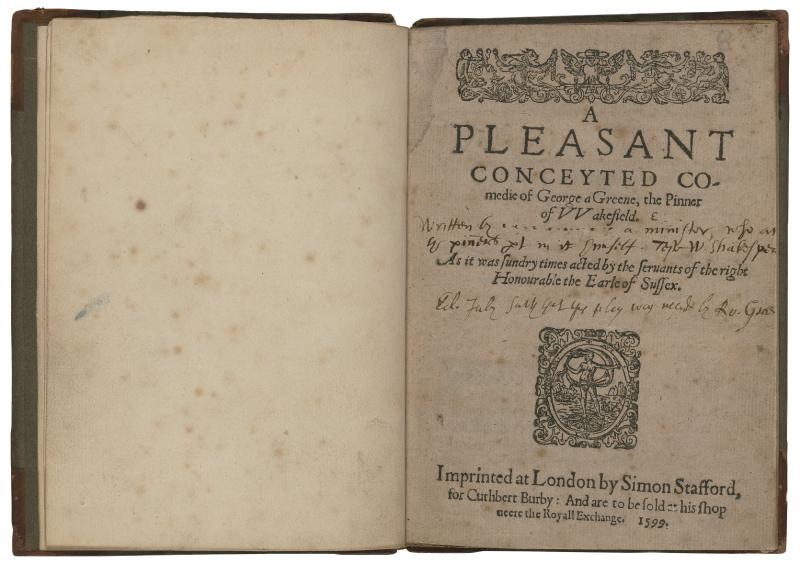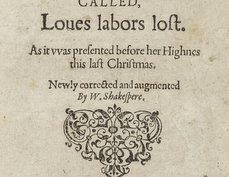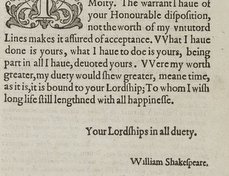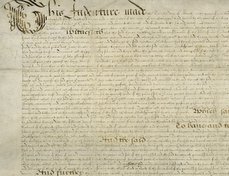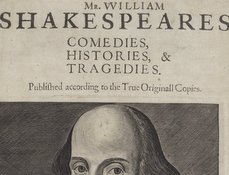Terms of use
Images that are under Folger copyright are licensed under a Creative Commons Attribution-ShareAlike 4.0 International License. This allows you to use our images without additional permission provided that you cite the Folger Shakespeare Library as the source and you license anything you create using the images under the same or equivalent license. For more information, including permissions beyond the scope of this license, see Permissions. The Folger waives permission fees for non-commercial publication by registered non-profits, including university presses, regardless of the license they use. For images copyrighted by an entity other than the Folger, please contact the copyright holder for permission information.
Copy-specific information
Title: A pleasant conceyted comedie of George a Greene, the pinner of VVakefield. As it was sundry times acted by the seruants of the right Honourable the Earle of Sussex.
Date: Imprinted at London : By Simon Stafford, for Cuthbert Burby: and are to be sold at his shop neere the Royall Exchange, 1599.
Repository: Folger Shakespeare Library, Washington, DC, USA
Call number and opening: STC 12212, title page
View online bibliographic record
Alan H. Nelson, "George a Greene: George Buc interviews William Shakespeare and Edward Juby," Shakespeare Documented, https://doi.org/10.37078/233.
Folger Shakespeare Library, STC 12212. See Shakespeare Documented, https://doi.org/10.37078/233.
Sometime after Sir George Buc, the future Master of the Revels, purchased the anonymous play George a Greene, Pinner of Wakefield shown here, he added two manuscript notes to the title page. Seeking to establish the identity of the playwright, Buc made separate approaches to William Shakespeare and to Edward Juby, recording their responses.
Written by ............ a minister, who ac<ted>
the pinners part in it himself. Teste W. Shakespea<re>
Ed. Iuby saith that this play was made by Ro. Gree<ne>
This annotated quarto is one of the most “theatrical” of all surviving Shakespeare documents as it was brought about through interactions with many elements of the theater world.
Edward Juby was a leading member of the Lord Admiral’s men, which was established in 1594 and became the Prince’s Players in 1603. William Shakespeare was a leading member of the Lord Chamberlain’s men, which was also established in 1594 and became the King’s Men in 1603. Juby and Shakespeare remained members of their companies until their deaths in 1618 and 1616 respectively
Evidently both Juby and Shakespeare were involved in the performances of George a Greene by three different companies: Sussex’s, the Lord Admiral’s, and the Lord Chamberlain’s Men, as recorded in Philip Henslowe’s “diary” in December 1593 and January 1594. The 1599 title page gives the play additionally to Derby’s and Pembroke’s men. The last performance of George a Greene that year, on January 21, 1594, was followed a day later by the first known performance of Shakespeare’ Titus Andronicus. Titus was published anonymously the same year. Shakespeare may have been involved with George a Greene as an actor, and with Titus Andronicus as both actor and playwright.
After its performances in 1593-4, George a Greene was entered into the Stationers Register in 1595, and published in 1599. As Master of the Revels, Buc would license plays for the press beginning in 1607, and for the stage beginning in 1610. But he had the “reversion” of the office much earlier, meaning that he had paid for a positive guarantee that he would become Master upon the death or resignation of the current Master, Edmund Tilney. To learn the authorship of the anonymous George a Greene he approached two experienced actors whose companies had been involved in the production of the play five or six years before it was published.
Buc, who added the names of playwrights to other printed plays in his collection, asked a specifically theatrical question: who wrote this play?
He received two different answers: Juby said it was by Robert Green, a playwright who had died in 1592; Shakespeare said it was by someone (we don’t know because either Shakespeare or Buc couldn’t remember) who had been a minister and who had acted the pinner’s part himself.
Although the contradictory claims have never been reconciled, scholars are fairly certain that the play was not by Robert Green. Shakespeare may have been correct, except that we do not know any playwright of the time who was also a minister. Interestingly, Shakespeare—a player who wrote plays-- proposed that an actor doubled as the playwright.
Written by ........... a minister, who acted the pinner's part in it himself. Teste [By the testimony of] William Shakespeare
Edward Juby saith that the play was made by Robert Greene
Written by ............ a minister, who ac<ted>
the pinners part in it himself. Teste W. Shakespea<re>
Ed. Iuby saith that this play was made by Ro. Gree<ne>
Written by Alan H. Nelson
Sources
Alan H. Nelson, "George Buc, William Shakespeare, and the Folger George a Greene," Shakespeare Quarterly, 48 (Spring 1998), 74-83.
Last updated February 23, 2020

